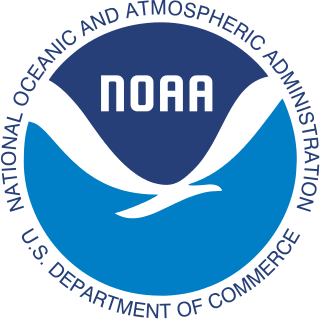Related Research Articles

Weather forecasting is the application of science and technology to predict the conditions of the atmosphere for a given location and time. People have attempted to predict the weather informally for millennia and formally since the 19th century.

The Weather Channel (TWC) is an American pay television channel owned by Weather Group, LLC, a subsidiary of Allen Media Group. The channel's headquarters are in Atlanta. Launched on May 2, 1982, the channel broadcasts weather forecasts and weather-related news and analysis, along with documentaries and entertainment programming related to weather. A sister network, Weatherscan, was a digital cable and satellite service that offered 24-hour automated local forecasts and radar imagery. Weatherscan was officially shut down on December 12, 2022. The Weather Channel also produces outsourced weathercasts, notably for CBS News and RFD-TV.

Skywarn is a program of the National Weather Service (NWS). Its mission is to collect reports of localized severe weather in the United States. These reports are used to aid forecasters in issuing and verifying severe weather watches and warnings and to improve the forecasting and warning processes and the tools used to collect meteorological data. Reports are also used by local emergency managers and public safety organizations.

A weather station is a facility, either on land or sea, with instruments and equipment for measuring atmospheric conditions to provide information for weather forecasts and to study the weather and climate. The measurements taken include temperature, atmospheric pressure, humidity, wind speed, wind direction, and precipitation amounts. Wind measurements are taken with as few other obstructions as possible, while temperature and humidity measurements are kept free from direct solar radiation, or insolation. Manual observations are taken at least once daily, while automated measurements are taken at least once an hour. Weather conditions out at sea are taken by ships and buoys, which measure slightly different meteorological quantities such as sea surface temperature (SST), wave height, and wave period. Drifting weather buoys outnumber their moored versions by a significant amount.

The National Hurricane Center (NHC) is the division of the United States' NOAA/National Weather Service responsible for tracking and predicting tropical weather systems between the Prime Meridian and the 140th meridian west poleward to the 30th parallel north in the northeast Pacific Ocean and the 31st parallel north in the northern Atlantic Ocean. The agency, which is co-located with the Miami branch of the National Weather Service, is situated on the campus of Florida International University in Westchester, Florida.

A tornado warning is a public warning that is issued to an area in the direct path of a tornado or a thunderstorm capable of producing a tornado. They are issued by weather forecasting agencies in some countries when an actual tornado or signs of a developing tornado, such as a funnel cloud or wall cloud, are reported by weather spotters, the public, or detected by weather radar.

The National Weather Service (NWS) is an agency of the United States federal government that is tasked with providing weather forecasts, warnings of hazardous weather, and other weather-related products to organizations and the public for the purposes of protection, safety, and general information. It is a part of the National Oceanic and Atmospheric Administration (NOAA) branch of the Department of Commerce, and is headquartered in Silver Spring, Maryland, within the Washington metropolitan area. The agency was known as the United States Weather Bureau from 1890 until it adopted its current name in 1970.

The Storm Prediction Center (SPC) is a US government agency that is part of the National Centers for Environmental Prediction (NCEP), operating under the control of the National Weather Service (NWS), which in turn is part of the National Oceanic and Atmospheric Administration (NOAA) of the United States Department of Commerce (DoC).

The Weather Prediction Center (WPC), located in College Park, Maryland, is one of nine service centers under the umbrella of the National Centers for Environmental Prediction (NCEP), a part of the National Weather Service (NWS), which in turn is part of the National Oceanic and Atmospheric Administration (NOAA) of the U.S. Government. Until March 5, 2013 the Weather Prediction Center was known as the Hydrometeorological Prediction Center (HPC). The Weather Prediction Center serves as a center for quantitative precipitation forecasting, medium range forecasting, and the interpretation of numerical weather prediction computer models.
The Weather Network (TWN) is a Canadian English-language discretionary weather information specialty channel available in Canada, the United States and the United Kingdom. It delivers weather information on television, digital platforms and TV apps.
The Bureau of Meteorology is an executive agency of the Australian Government responsible for providing weather services to Australia and surrounding areas. It was established in 1906 under the Meteorology Act, and brought together the state meteorological services that existed before then. The states officially transferred their weather recording responsibilities to the Bureau of Meteorology on 1 January 1908.

Oceanic and Atmospheric Research (OAR) is a division of the National Oceanic and Atmospheric Administration (NOAA). OAR is also referred to as NOAA Research.

NBC Weather Plus was an American weather-oriented digital multicast television network owned as a joint venture between NBC Universal and the local affiliates of the NBC television network. The service, which was broadcast in standard definition, was carried on the digital subchannels of many NBC affiliates and on the digital tiers of cable providers.

The Citizen Weather Observer Program (CWOP) is a network of privately owned electronic weather stations concentrated in the United States but also located in over 150 countries. Network participation allows volunteers with computerized weather stations to send automated surface weather observations to the National Weather Service (NWS) by way of the Meteorological Assimilation Data Ingest System (MADIS). This data is then used by the Rapid Refresh (RAP) forecast model to produce short term forecasts of conditions across the contiguous United States. Observations are also redistributed to the public.

The Community Collaborative Rain, Hail and Snow Network, or CoCoRaHS, is a network of volunteer weather observers in the United States, Canada, and the Bahamas that take daily readings of precipitation and report them to a central data store over the internet. The program is an example of citizen science.

The Ocean Prediction Center (OPC), established in 1995, is one of the National Centers for Environmental Prediction's (NCEP's) original six service centers. Until 2003, the name of the organization was the Marine Prediction Center. Its origins are traced back to the sinking of the RMS Titanic in 1912. The OPC issues forecasts up to five days in advance for ocean areas north of 31° north latitude and west of 35° west longitude in the Atlantic, and across the northeast Pacific north of 30° north latitude and east of 160° east longitude. Until recently, the OPC provided forecast points for tropical cyclones north of 20° north latitude and east of the 60° west longitude to the National Hurricane Center. OPC is composed of two branches: the Ocean Forecast Branch and the Ocean Applications Branch.

National Weather Service Lincoln, Illinois also known as National Weather Service Central Illinois is a weather forecast office responsible for monitoring weather conditions for 35 counties in Central and Southeastern Illinois. The Central Illinois office initially consisted of two forecast offices in Peoria and Springfield until the current location in Lincoln became the sole local forecast office in 1995. Federal meteorology offices and stations in the region date back to the 19th century when the Army Signal Service began taking weather observations using weather equipment at the Springer Building in Springfield. Since that time the presence of the National Weather Service greatly increased with the installation of new weather radars, stations and forecast offices. The current office in Lincoln maintains a WSR-88D (NEXRAD) radar system, and Advanced Weather Interactive Processing System (AWIPS) that greatly improve forecasting in the region. Lincoln is in charge of weather forecasts, warnings and local statements as well as aviation weather.
The National Weather Service Boston/Norton, Massachusetts, is a local office of the National Weather Service (NWS), run under the auspices of the NWS's Eastern Region. This weather forecast office (WFO) is responsible for monitoring weather conditions throughout most of southern New England. The southern New England weather forecast office provides warning and forecast services for most of Massachusetts, Northern Connecticut, and all of Rhode Island. Besides public weather services, WFO Norton (BOX) provides marine, aviation, fire weather, and hydrological forecast services. Additional hydrologic information is provided by the co-located Northeast River Forecast Center (NERFC).

The NOAA Cooperative Observer Program (COOP) is a citizen weather observer network run by the U.S. National Weather Service (NWS) and National Centers for Environmental Information (NCEI). Over 8,700 volunteers from the fifty states and all territories report at least daily a variety of weather conditions such as daily maximum and minimum temperatures, 24-hour precipitation totals, including snowfall, and significant weather occurrences throughout a day that are recorded via remarks in observer logs. Some stations also report stream stage or tidal levels.

2LT Wallace Patillo Reed was a World War II U.S. Army officer, U.S. military meteorologist, and the first ever African-American meteorologist in the U.S. military. Reed served at Tuskegee Army Air Field in Alabama as the chief weather officer responsible for the all-African American Tuskegee Airmen. Reed regularly advised Tuskegee Airmen pilots and instructors on weather maps and forecasts.
References
- ↑ "National Weather Service, Lincoln IL -- Significant Weather Observer Program". crh.noaa.gov. Retrieved 24 May 2013.